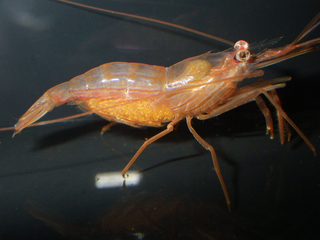
The Caridea, commonly known as caridean shrimp or true shrimp, are an infraorder of shrimp within the order Decapoda. This infraorder contain all species of true shrimp. They are found widely around the world in both fresh and salt water. Many other animals with similar names – such as ghost shrimps, mud shrimps, and boxer shrimps – are not true shrimps, but many have evolved features similar to true shrimps.

The Decapoda or decapods are an order of crustaceans within the class Malacostraca, including many familiar groups, such as crayfish, crabs, lobsters, prawns, and shrimp. Most decapods are scavengers. The order is estimated to contain nearly 15,000 species in around 2,700 genera, with around 3,300 fossil species. Nearly half of these species are crabs, with the shrimp and Anomura including hermit crabs, porcelain crabs, squat lobsters making up the bulk of the remainder. The earliest fossil decapod is the Devonian Palaeopalaemon.

Eucarida is a superorder of the Malacostraca, a class of the crustacean subphylum, comprising the decapods, krill, Amphionides and Angustidontida. They are characterised by having the carapace fused to all thoracic segments, and by the possession of stalked eyes.

Hippolytidae is a family of cleaner shrimp, also known as broken-back shrimp or anemone shrimp. The term "broken-back shrimp" also applies to the genus Hippolyte in particular and "cleaner shrimp" is sometimes applied exclusively to Lysmata amboinensis.

Lysmata debelius is a species of cleaner shrimp indigenous to the Indo-Pacific. It is popular in the aquarium trade, where it is known as the fire shrimp, blood shrimp or scarlet cleaner shrimp.

Troglocaris is a genus of freshwater shrimp in the family Atyidae. These stygobitic, whitish and eyeless shrimp are found in Southern Europe. Although locally very common, the small ranges of the individual species make them highly vulnerable to habitat loss, for example by water extraction. Their underground habitat is often extremely stable; for example, the Vipavska jama cave in Slovenia is home to a population of T. anophthalmus, and its water only varies from 10 °C (50 °F) in the winter to 11 °C (52 °F) in the summer. In some Dinaric caves, notably Vjetrenica, as many as three species may occur together.

Lysmata wurdemanni, commonly known as the peppermint shrimp, is a species of shrimp.
Lebbeus clarehannah is a species of shrimp discovered in 2005 off the southwest coast of Western Australia. Former NBA player Luc Longley won the rights to name the shrimp in an eBay auction. He named the shrimp after his daughter, Clare Hanna Longley, as a birthday present to her.

Lebbeus is a genus of shrimp in the family Hippolytidae. It includes a species whose name was auctioned in 2009 to raise funds for conservation; Luc Longley won with a bid of A$3,600. He named the shrimp Lebbeus clarehannah. The following species are included:

Lysmata is a genus of shrimp in the infraorder Caridea, the caridean shrimp. The genus belongs to the family Lysmatidae. Lysmata are popular ornamental shrimp in the marine aquarium trade for their bright color patterns, interesting behaviors, and ability to control certain aquarium pests such as sea anemones of the genus Aiptasia. They are known to command high prices on the pet market.
Lysmata vittata, the peppermint shrimp, is a species of shrimp, native to the Indo-Pacific from East Africa to the Philippines, Japan, Australia and New Zealand.
Birulia is a genus of shrimp. It is one of a group of genera that are usually treated as part of the family Hippolytidae, but have also been separated off as the family Thoridae.
Campylonotoidea is a superfamily of shrimp, containing the two families Campylonotidae and Bathypalaemonellidae. Fenner A. Chace considered it to be the sister group to the much larger superfamily Palaemonoidea, with which it shares the absence of endopods on the pereiopods, and the fact that the first pereiopod is thinner than the second. Using molecular phylogenetics, Bracken et al. proposed that Campylonotoidea may be closer to Atyoidea. There are sixteen described species in 3 genera; no fossils are known.

Shrimp are decapod crustaceans with elongated bodies and a primarily swimming mode of locomotion – most commonly Caridea and Dendrobranchiata. More narrow definitions may be restricted to Caridea, to smaller species of either group or to only the marine species. Under a broader definition, shrimp may be synonymous with prawn, covering stalk-eyed swimming crustaceans with long narrow muscular tails (abdomens), long whiskers (antennae), and slender legs. Any small crustacean which resembles a shrimp tends to be called one. They swim forward by paddling with swimmerets on the underside of their abdomens, although their escape response is typically repeated flicks with the tail driving them backwards very quickly. Crabs and lobsters have strong walking legs, whereas shrimp have thin, fragile legs which they use primarily for perching.

Lysmata grabhami is a species of saltwater shrimp in the family Hippolytidae. It was first described by Gordon in 1935. It occurs in the tropical and subtropical Atlantic Ocean and is a cleaner shrimp, operating a cleaning station to which fish come to have parasites removed.

Lysmata boggessi is a species of saltwater shrimp first classified as Lysmata wurdemanni. It is found in shallow waters of the Atlantic Ocean, and can be distinguished by its coloration pattern.
Lysmata bahia is a species of saltwater shrimp first classified as Lysmata wurdemanni. It is found in shallow waters of the Atlantic Ocean, and can be distinguished by its coloration pattern.
Lysmata pederseni is a species of saltwater shrimp first classified as Lysmata wurdemanni. It is found in shallow waters of the Atlantic Ocean, and can be distinguished by its coloration pattern and its association with tube sponges.
Palaemon floridanus is a species of shrimp of the family Palaemonidae.
Thoridae is a family of cleaner shrimp, also known as broken-back shrimp or anemone shrimp.










